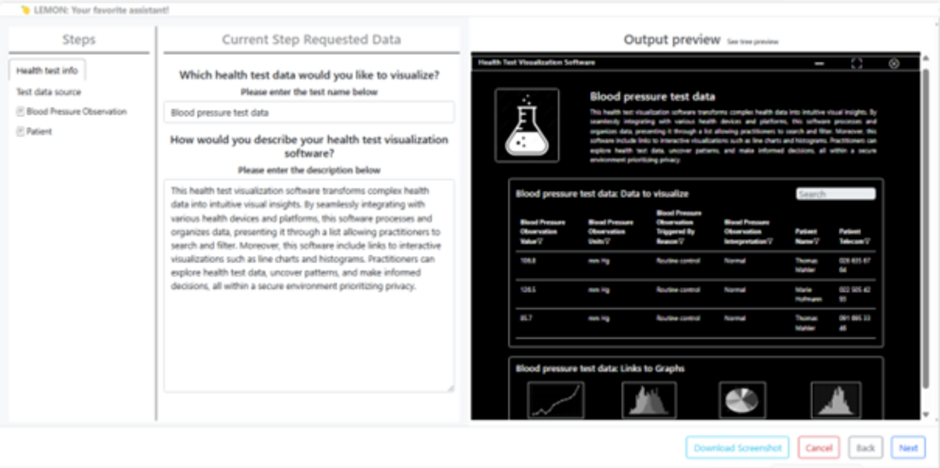
Towards digital health software development democratization for non-software developers with the LEMON assistant
Wissensdatenbank Systemauswahl & Implementierung Mensch Schulung & Digitale Kompetenz C.3: Künstliche Intelligenz-basierte Software-Fabrik für MedTech-AnwendungenDemocratizing digital health software development is essential for advancing successful digitalization processes within healthcare organizations. This article explores how LEMON—an AI-based assistant—can lower technical knowledge barriers during digital health software development for non-software developers.

Problembeschreibung, Forschungsfrage und Relevanz
In digital health software development, software developers face the challenge of effectively gathering the requirements, needs, and points of view from non-software developers in healthcare organizations—i.e., healthcare practitioners, patients, innovation managers, and business analysts, among other roles.
Communicating software requirements is error-prone due to the technical knowledge gap between non-software and software developers. These issues with communication represent entry barriers that hinder digital health software development democratization, making it difficult for non-software developers to participate actively in the software development process. Thus, how can we democratize digital health software development for non-software developers within healthcare organizations? In this knowledge article, we devise an artificial intelligence-based assistant named LEMON—Language for spEcifying and MOdelling patterNs—to address such a research question. LEMON allows non-software developers to communicate their digital health software requirements to software developers. LEMON guides non-software developers to answer a set of questions step-by-step to elicit their digital health software requirements. As a result, LEMON automatically produce a digital health software prototype that non-software developers can validate and provide instant feedback to software developers.
LEMON uses the concept of requirements pattern together with low-code / no-code to produce prototypes. We have device LEMON based on well-founded and research-based literature (Kudo et al., 2020; Karagiannis et al., 2019; Ya’u et al., 2020; Palomares et al., 2017), as well as previous experiences with requirements patterns in the healthcare domain (Sardi et al. 2022). With LEMON, we aim to empower non-software developers within healthcare organizations, enabling them to lead digitalization processes by focusing on their specific requirements and reducing technical knowledge entry barriers.

Ergebnisse und Erkenntnisse
Conducted workshops, interviews, and empirical efforts in LEMON design phase; received positive feedback. First version developed (Fig. 1); upcoming quasi-experiment planned.

Empfehlungen für die Praxis
- Avoid misalignments between digital health software expectations and results. Non-software developers experience frustration when software does not meet their expectations. Thus, we emphasize the need for solutions that utilize fast prototyping low-code/no-code approaches to streamline feedback loops between non-software developers and the software development process outcome.
- Develop digital health software collaboratively with the users. Developing digital health software doesn't guarantee its adoption. That's why we advocate involving users in design and development, particularly in early phases. Allowing users to express their needs throughout the process facilitates gathering diverse perspectives for successful digital health software solutions.
- Time: the most scarce resource for many roles in healthcare. A major pain point is practitioners' limited availability for long requirement elicitation meetings. This cycle, where practitioners lack time to express needs, impedes developers from delivering effective solutions. To break this cycle, we advocate for efficient requirement elicitation tools that attract busy roles to participate in the software development process.
Literatur und andere Quellen
L. Sardi, A. Idri, et al., “A Reusable Catalog of Requirements for Gamified Mobile Health Applications,” in ENASE, 2022, pp. 435–442.
T. N. Kudo, R. F. Bulcão-Neto, et al., “Requirement patterns: A tertiary study and a research agenda,” IET Software, vol. 14, no. 1., 2020, pp. 18–26.
D. Karagiannis, M. Lee, and R. A. Buchmann, “Using Metamodeling for Requirements Engineering: A Best-Practice with ADOxx,” in RE, 2019, pp. 498–499.
B. I. Ya’u, A. Nordin, et al., “Analysis of Expert’s Opinion on Requirements Patterns for Software Product Families Framework Using GQM Method,”ICCST,2020,pp.135–144.
C. Palomares, C. Quer, et al., “Requirements reuse and requirement patterns: a state of the practice survey,” Empir Softw Eng, vol. 22, no. 6, 2017, pp. 2719–2762.
Zitierung des Beitrags
Towards digital health software development democratization for non-software developers with the LEMON assistant


